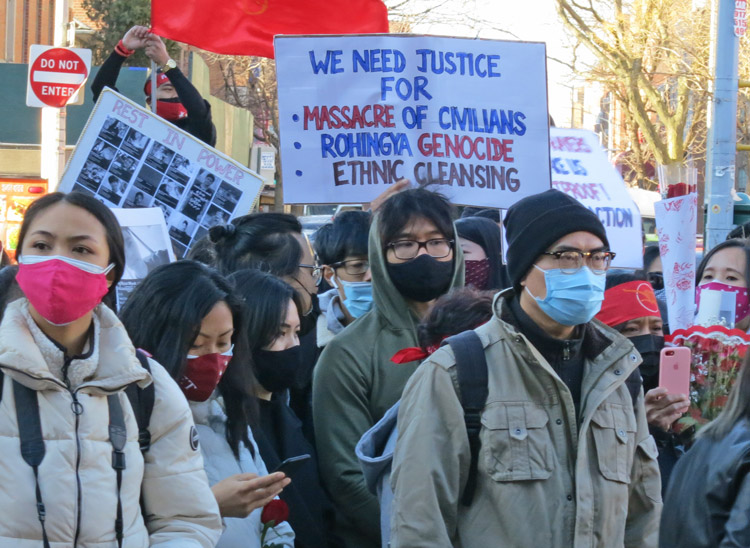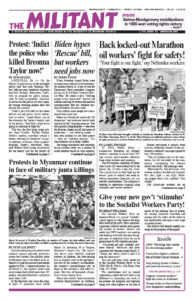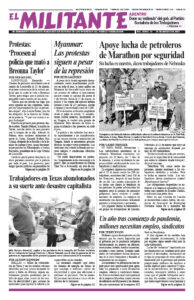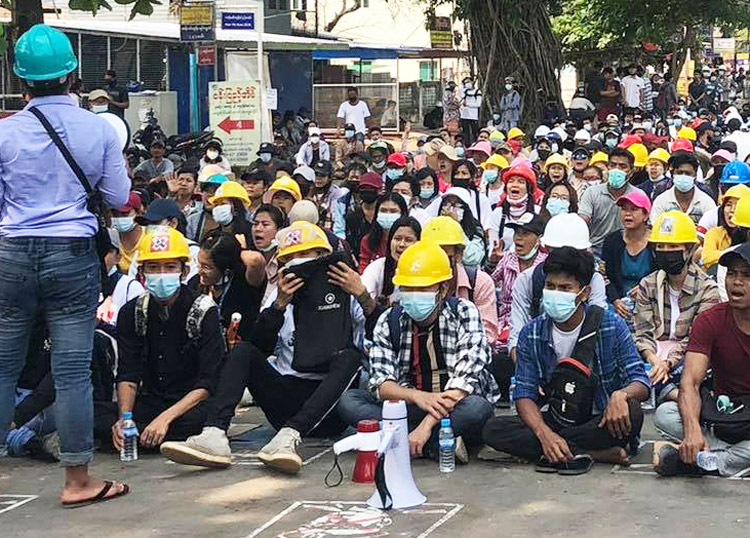Despite unleashing ever more brutal violence against peaceful protesters across the country, the military junta in Myanmar has so far failed in its attempts to quell the massive movement against its Feb. 1 seizure of power. As of March 17, the regime’s police and army troops had killed more than 217 people, wounded hundreds, and jailed more than 2,100.
In the bloodiest day since the coup, at least 71 protesters were killed March 14, including 39 in Yangon, Myanmar’s largest city. The repressive forces also violently attacked protests in Hpakan, the jade-mining hub in Kachin state in the northeastern part of the country; in Mandalay, the country’s second-largest city; in Bago in the southwest; and other regions. But tens of thousands of protesters keep coming back.
Police and soldiers have repeatedly attacked demonstrators in working-class and industrial neighborhoods that surround Yangon, including Hlaing Thar Yar, North Okkalapa, and Shwepyithar, where huge garment and other factories are located. Unions there have been fighting for years for better wages and work conditions.
“They are not dispersing the protests. They are just murdering the people with violence,” one protester in Hlaing Thar Yar told Irrawaddy, a Yangon-based news site that backs the Civil Disobedience Movement.
Gen. Min Aung Hlaing reimposed direct military rule Feb. 1, just days before the new parliament was to convene after Aung San Suu Kyi and her National League for Democracy won the November 2020 election in a landslide. Suu Kyi has been the head of the government since 2016.
On March 8, 18 unions, union federations and farm and farmworker associations began a general strike aimed at toppling the regime. Attacks by the government on news media and frequent shutdowns of internet and cellphone service have made it more difficult to gauge the spread and impact of the strike.
But one indication, according to the Frontier Myanmar website, is that strikes by truck drivers, port workers, custom agents and staff at other government agencies have brought sea-bound trade to a halt at Yangon’s port.
In an attempt to break the strike on the railroads, cops and soldiers evicted 1,000 families from government-owned housing for rail workers in Yangon March 10. The soldiers told the workers their homes would be bulldozed and their families shot down if they refused to leave. The police and soldiers confiscated rice and other goods that had been donated to the rail workers in solidarity with their strike.
Martial law in six townships
Arson attacks carried out by unknown individuals against dozens of garment factories in Yangon March 14 dealt a blow to the strike action by garment workers and others across the country.
The attacks gave the junta a pretext to declare martial law in six of Yangon’s 33 townships. This includes trials by military courts, and the threat of the death penalty, on any of 23 different charges, including spreading “false news” or having ties to “unlawful” associations.

The attacks were reported to be aimed at Chinese owners, because of Beijing’s long-standing support for the military. While most of the factories attacked had ties to Beijing at least one was owned by a Taiwanese company and two by a Japanese retailer. Some employees of the companies were injured in the attacks.
Anger at the regime in Beijing is not surprising. Beijing is the largest supplier of arms to the Myanmar army, and has numerous joint enterprises with Myanmar military-owned companies. While demanding the junta protect Beijing-owned factories, the Chinese government has refused to condemn the coup, calling it an “internal matter” in Myanmar.
Numerous protests in front of the Chinese Embassy in Yangon have called for Beijing to change its position and condemn the coup.
Prior to the coup, Beijing had friendly relations with both the army high command and the National League for Democracy, the bourgeois party Suu Kyi helped found. The rulers in Beijing care little about who is in the government in Myanmar, as long as they back the economic and political interests of the Chinese rulers.
By appearing to target “Chinese” companies, the arson attacks are also a threat to the unity among Myanmar’s 135 ethnic minorities and to the protest movement. Divisions between the predominantly Buddhist Bamar majority, nearly 70% of the population, and dozens of ethnic minorities, including Shan, Karen, Rakhine, Rohingya, Kachin, Chin and Chinese, are a legacy of British colonial rule.
At a March 13 demonstration of 500 in New York City in solidarity with the fight against the military coup, this reporter spoke with Win Naing, who is from the Chinese ethnic minority in Myanmar.
“Some people in Myanmar said that the Chinese don’t care, but we are part of the Burmese people,” he said. After Kyal Sin, a young ethnic Chinese woman, was shot dead at a March 3 protest in Mandalay, “more people could see that ethnic Chinese are part of the fight against the military coup.”
Linn Lunn HlaMyaing told the Militant that he is from the Bamar ethnic majority in Myanmar. “I tell everyone that it doesn’t matter what your race or color or religion, we are human and have to be united against the military dictatorship.”
The working class in Myanmar has grown explosively over the last decade, alongside the expansion in foreign investment. In the garment industry alone the number of workers grew from 340,000 in 2018 to some 700,000 — mostly women — by 2020. Along with companies based in China, others are based in Singapore, Japan, the United Kingdom and the U.S., all taking advantage of the low wages in Myanmar.
These shops bring together workers of all nationalities, drawn from the countryside by the work. The General Strike Committee of Nationalities made up of young people from 27 ethnic groups, stands firmly with all those “who are fighting for the end of dictatorship in all different ways,” the group said March 15, after the latest increase in violence by the junta. “We are determined to fight together until we reach our ultimate goal.”


